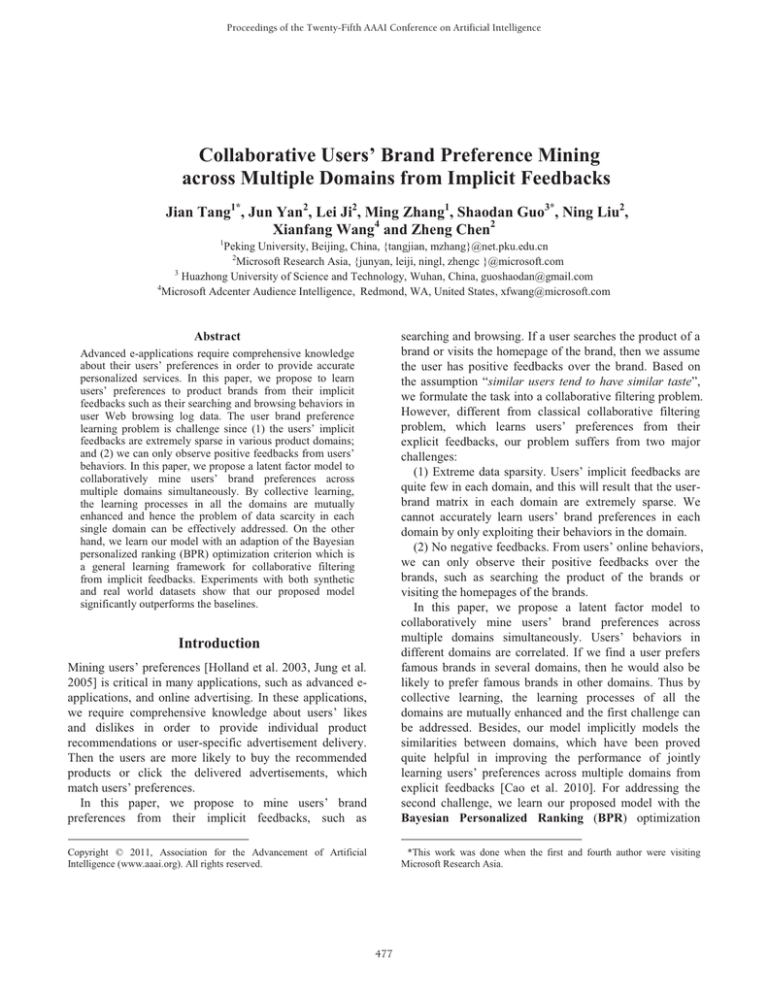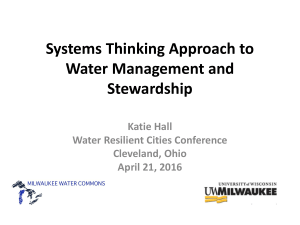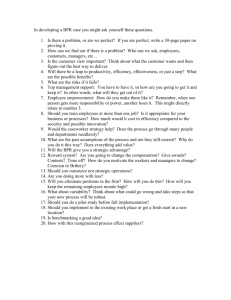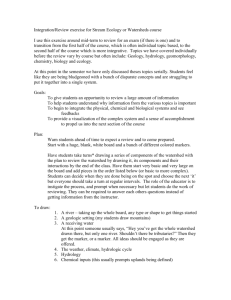
Proceedings of the Twenty-Fifth AAAI Conference on Artificial Intelligence
Collaborative Users’ Brand Preference Mining
across Multiple Domains from Implicit Feedbacks
Jian Tang1*, Jun Yan2, Lei Ji2, Ming Zhang1, Shaodan Guo3*, Ning Liu2,
Xianfang Wang4 and Zheng Chen2
1
Peking University, Beijing, China, {tangjian, mzhang}@net.pku.edu.cn
2
Microsoft Research Asia, {junyan, leiji, ningl, zhengc }@microsoft.com
3
Huazhong University of Science and Technology, Wuhan, China, guoshaodan@gmail.com
4
Microsoft Adcenter Audience Intelligence, Redmond, WA, United States, xfwang@microsoft.com
Mining users’ preferences [Holland et al. 2003, Jung et al.
2005] is critical in many applications, such as advanced eapplications, and online advertising. In these applications,
we require comprehensive knowledge about users’ likes
and dislikes in order to provide individual product
recommendations or user-specific advertisement delivery.
Then the users are more likely to buy the recommended
products or click the delivered advertisements, which
match users’ preferences.
In this paper, we propose to mine users’ brand
preferences from their implicit feedbacks, such as
searching and browsing. If a user searches the product of a
brand or visits the homepage of the brand, then we assume
the user has positive feedbacks over the brand. Based on
the assumption “similar users tend to have similar taste”,
we formulate the task into a collaborative filtering problem.
However, different from classical collaborative filtering
problem, which learns users’ preferences from their
explicit feedbacks, our problem suffers from two major
challenges:
(1) Extreme data sparsity. Users’ implicit feedbacks are
quite few in each domain, and this will result that the userbrand matrix in each domain are extremely sparse. We
cannot accurately learn users’ brand preferences in each
domain by only exploiting their behaviors in the domain.
(2) No negative feedbacks. From users’ online behaviors,
we can only observe their positive feedbacks over the
brands, such as searching the product of the brands or
visiting the homepages of the brands. In this paper, we propose a latent factor model to
collaboratively mine users’ brand preferences across
multiple domains simultaneously. Users’ behaviors in
different domains are correlated. If we find a user prefers
famous brands in several domains, then he would also be
likely to prefer famous brands in other domains. Thus by
collective learning, the learning processes of all the
domains are mutually enhanced and the first challenge can
be addressed. Besides, our model implicitly models the
similarities between domains, which have been proved
quite helpful in improving the performance of jointly
learning users’ preferences across multiple domains from
explicit feedbacks [Cao et al. 2010]. For addressing the
second challenge, we learn our proposed model with the
Bayesian Personalized Ranking (BPR) optimization
Copyright © 2011, Association for the Advancement of Artificial
Intelligence (www.aaai.org). All rights reserved.
*This work was done when the first and fourth author were visiting
Microsoft Research Asia.
Abstract
Advanced e-applications require comprehensive knowledge
about their users’ preferences in order to provide accurate
personalized services. In this paper, we propose to learn
users’ preferences to product brands from their implicit
feedbacks such as their searching and browsing behaviors in
user Web browsing log data. The user brand preference
learning problem is challenge since (1) the users’ implicit
feedbacks are extremely sparse in various product domains;
and (2) we can only observe positive feedbacks from users’
behaviors. In this paper, we propose a latent factor model to
collaboratively mine users’ brand preferences across
multiple domains simultaneously. By collective learning,
the learning processes in all the domains are mutually
enhanced and hence the problem of data scarcity in each
single domain can be effectively addressed. On the other
hand, we learn our model with an adaption of the Bayesian
personalized ranking (BPR) optimization criterion which is
a general learning framework for collaborative filtering
from implicit feedbacks. Experiments with both synthetic
and real world datasets show that our proposed model
significantly outperforms the baselines.
Introduction
477
criterion [Rendle et al. 2009], which is a general learning
framework for collaborative filtering from users’ implicit
feedbacks. Experiments with both synthetic and real world
datasets show that the collective learning methods for
multiple domains outperform the methods for single
domain and our proposed model performs the best due to
the consideration of similarities between domains.
For convenience, we define:
that denotes the set of brands for which user u has positive
feedbacks in domain d.
Data Analysis
Users’ Brand Preference Mining
The main problem of learning from users’ implicit
feedbacks is that only positive feedbacks are available and
the remaining data is a mixture of positive and negative
examples. Many classical collaborative filtering methods
a positive
create the training data by giving each
class label and others a negative one [Hu et al. 2008, Pan et
al. 2008], and then a model is fitted to this data. As
mentioned in [Rendle et al. 2009], for a model with enough
expressiveness, this model cannot rank at all as it predicts
only 0s for the remaining data. Here we use a similar
strategy as done in [Rendle et al. 2009], we create the
brand preference pairs as our training data. If user u has
positive feedbacks for brand but none for brand j, we
assume user u prefers to . In [Rendle et al. 2009], all the
preference pairs are treated equally, but here we associate
each preference pair with the confidential value
which
measures the confidence of user u prefers i to j Thus the
training data derived from user u’s behaviors in domain d
is defined as:
(3)
and the total training data T is:
(4)
The task of users’ brand preference mining is to provide
each user with a ranked list of brands in each domain. In
this paper, we consider mining users’ brand preferences
from their implicit feedbacks, such as searching and
browsing. The key difference between users’ implicit
feedbacks and their explicit feedbacks is that only positive
feedbacks are available. Based on the basic assumption
“similar users tend to have similar taste”, we propose to
collaboratively mine users’ brand preferences, which
results in a collaborative filtering problem. Furthermore,
users’ behaviors in each domain are quite scarce, thus we
propose to mine users’ brand preferences across multiple
domains simultaneously.
Notations
We first define the notations to be used in this paper. Let
D be the set of all domains, U the set of all users, and
the set of brands in the domain d. We use
to represent
the number of observations between user u and brand i in
domain d, which refers to the number of times user u
searched queries containing brand i or visited the
homepage of brand i. We introduce another set of binary
variables
to indicate whether user u likes brand i. The
values are defined as follows:
Bayesian Personalized Ranking (BPR) for
Users’ Brand Preference Mining
where is the increase rate of confidence value with
respect to the number of positive feedbacks. We set
in our experiments for the best performance.
In this section, we present a solution for the problem of
users’ brand preference mining. First, we describe a
learning framework for collaborative filtering from implicit
feedbacks: Bayesian Personalized Ranking (BPR)
optimization criterion [Rendle et al. 2009]. Second, we
describe the factorization models. We first describe the
collective matrix factorization model with BPR
optimization criterion. Then we describe our factorization
model for the problem and present the detailed learning
algorithm with BPR optimization criterion.
Problem Formulation
Bayesian Personalized Ranking Criterion
The problem of users’ brand preference mining is to
provide a personalized ranked list of brands in each
domain. For each domain d and user u, we want to predict
a total order
over the brands, and
meanwhile
has to meet the properties of a total order:
In this subsection, we describe the Bayesian Personalized
Ranking (BPR) criterion, which is a general framework
for collaborative filtering from implicit feedbacks.
In order to find the best ranking
, the BPR
framework aims to maximize the following posterior
probability:
, we can see that
From the definition of
indicate whether user u has positive feedbacks over brand i,
ignoring the number of times. Furthermore, a set of
variables
are introduced to measure the confidence in
observing
, defined as:
478
problem, and the other one is our proposed model. We will
present how the two models are learned with BPR.
Both of the two factorization models predict a realvalued function
, where the score
in entry
represents user u’s preference score for
brand i in domain d. In order to learn the models with BPR
optimization criterion, we define:
(5)
where represents the model parameters. By assuming the
independence of users’ behaviors in different domains and
the independence of users in each domain, the model
parameters can be found by:
(6)
Furthermore,
can be expressed with
Collective Matrix Factorization
The matrix factorization methods or latent factor models
and
associate each user u with a latent vector
brand i in domain d with a latent vector
, where f
is the dimension of the latent factors. The preference score
is modeled via:
The probability that user u prefers brand i to j is defined
as:
The model parameters for the matrix factorization are
. For learning the model with BPR
optimization criterion, we need to calculate the gradients
with respect to the model parameters, which are calculated
by:
where
is the logistic function
.
is a real-valued function of model parameters ,
i.e.
We will use
to represent
for short in the rest of the paper.
We have discussed the likelihood function. As for the
prior
, we assume follows a multivariate Gaussian
distribution
In total, the BPR optimization
criterion can be finally formulated as:
(13)
The model parameters for users
and brands
for each domain d are learned collectively with
BPR optimization criterion. By the collectively learning,
the matrix factorization model can address the first
challenge to some extent. Meanwhile, by learning with
BPR optimization criterion, which is a general learning
framework for collaborative filtering from implicit
feedbacks, the second challenge is effectively addressed.
The optimization criterion (9) is differentiable, thus
gradient descent based algorithm can be easily adapted to
the problem. Instead, a bootstrap sampling of training data
based stochastic gradient-descent algorithm is proposed
[Rendle et al. 2009]. Given a training example
,
the gradient of BPR-OPT with respect to a model
parameter is calculated as:
And the parameter
where
Our Proposed Model
The matrix factorization model introduced above can
address the first challenge to some extent by collective
learning. However, the model ignores one important factor:
the degrees of relatedness between different domains. The
model just aggregates the brands in all the domains
together and then factorizes the aggregated user-brand
matrix, which treats the similarities between domains
equally. However, the similarities between different
domains are different. Thus we introduce another group of
latent factors
to associate with each domain d, and
the preference score
is modeled as:
can be updated with:
is the learning rate.
Factorization Models
Factorization models are quite popular for collaborative
filtering problems and have been proved quite successful
[Hu et al. 2008, Rendle et al. 2009]. In this subsection, we
describe two factorization models for the problem of users’
brand preference mining. The first one is the classical
matrix factorization method for collaborative filtering
as above are two-fold. The
The reasons of modeling
first term
is the same as classical matrix factorization,
which is used to model the relationship between user and
brand; the second term is used to model the relationship
between brand and domain, which implicitly models the
relationship between different domains.
479
The parameters in our model are user, item and domain
, and the gradients of these
factors, i.e
parameters are:
in two steps. First, we extracted the actors of movies from
the IMDB website and removed the movies whose actors
we cannot get. Second, as our problem is tailored for
implicit feedbacks, users’ ratings that are greater than 2 are
treated as positive feedbacks, and if a user has a positive
feedback over a movie, we assume that the user has
positive feedbacks over all the actors of the movie. The
description of the final dataset is summarized in Table 2.
SearchLog. This dataset is extracted from the search log of
a commercial search engine. We firstly predefine the brand
list in four domains: digital camera, cell phone, computer,
and car. Then we extracted users’ search behaviors,
including search queries and clicked URLs, from 10th, Nov,
2010 to 16th, Nov, 2010. If a user searched queries or
clicked URLs containing the name of a brand in one of the
four domains, then we think the user has positive
feedbacks over the brand and has behaviors in the domain.
We remove users who have behaviors in fewer than two
domains. The description of the dataset is presented in
Table 3.
Table 2. Description of MovieLens dataset
Domain
#Users
#Actors
#Avg. User
The complete procedure for learning our model with
BPR criterion is summarized in Table 1.
Table 1: Learning Algorithm for Our model
Procedure
For each u, draw
,
for each d, draw
,
for each
, draw
.
repeat
draw
uniformly from training data T.
Behaviors
until convergence
end procedure
From Table 1, we can see that the learning complexity
of our model is
, which is linear to the dimension of
the latent factors.
Action
678
209
50.7
Comedy
725
209
53.7
Drama
828
209
54.4
Thriller
240
209
19.8
Table 3. Description of SearchLog dataset
Domain
#Users #Brands
#Avg. User
Behaviors
Experiments
In this section, we describe the experiments. We compare
our model with three baselines: user based k-NearestNeighbor [Breese et al. 1998] and matrix factorization
model learned with BPR [Rendle et al. 2009] for each
single domain, and the matrix factorization model for
multiple domains learned with BPR.
Digital Camera
4297
11
1.8
Cell Phone
14228
31
2.5
Computer
10743
26
1.6
Car
8889
52
3.2
Evaluation Metric
We use the leave-one-out evaluation schema, as done in
[Rendle et al. 2009]. For each user u, we remove one
positive feedback randomly from his behaviors in each
domain, i.e. we remove one entry from
for each user u
and domain d. Thus a pair of sets, namely disjoint training
set
and test set
for each domain d is obtained.
All the models are learned with the training data in all the
domains and evaluated on all the test dataset
with the
average AUC statistic metric:
Datasets
We use two datasets for our experiments. One is a
synthetic dataset from the public dataset MovieLens for
movie recommendation; the other is extracted from the
search log of a commercial search engine.
MovieLens. The dataset contains users’ explicit ratings
(from 1 to 5 stars) for movies and the genres of movies are
also provided. We use four most popular genres to form
the different domains. In order to better match the task of
this paper, we use this dataset to mine users’ preferences
towards actors instead of movies. The dataset is processed
where
u:
480
is all the evaluation pairs in domain d for user
dataset becomes, our model performs consistently better
than the baselines. Furthermore, the performance gain of
our model increases when the data sparseness becomes
serious.
We repeated the experiments 10 times and the final
experimental results are the average results of these
experiments.
0.78
Baselines and Parameter Settings
0.76
We compare our model with the following baselines:
(1) User-KNN [Breese et al. 1998]: user-based knearest-neighbor method for each domain
individually. The number of neighbors, k is set to
80 in our experiments.
(2) BPR-MF [Rendle et al. 2009]: Matrix
factorization for each domain individually with
BPR learning criterion.
(3) BPR-CMF: collective matrix factorization for all
the domains with BPR learning criterion.
Our model is a collective learning method and hence we
represent our proposed model with BPR-CL for short.
For all the models learned with BPR, the parameters are
initialized with
; the learning rate
; the
regularization parameter
.
0.74
0.72
AUC
0.7
0.68
0.66
0.62
0.6
1
1.5
2
2.5
3
3.5
Number of average user behavior(sparsity)
4
4.5
5
Figure 2: The influence of sparseness with different
methods on MovieLens dataset
Based on the results of the synthetic dataset Movielens,
we can conclude that learning multiple domains
simultaneously can effectively address the data sparseness
in each domain. Besides, by implicitly modeling the
relationship between different domains, the proposed
model performs the best among all the models and the
performance gain further increase when the data sparseness
becomes serious.
In order to further validate the conclusion obtained from
the synthetic dataset, we repeated the experiments on the
real world dataset SearchLog. The results are presented in
Figure 3.
Results
In this subsection, we report our experimental results both
on the synthetic and real world datasets.
0.74
0.72
0.7
0.68
AUC
User-KNN
BPR-MF
BPR-CMF
BPR-CL
0.64
0.66
0.8
0.64
0.78
0.62
0.76
User-KNN
BPR-MF
BPR-CMF
BPR-CL
0.6
0.74
AUC
0.58
5
10
15
20
25
30
35
number of dimension
40
45
0.72
0.7
50
0.68
Figure 1: the performance of different methods on
MovieLens dataset
Figure 1 shows the results on MovieLens dataset with
different methods. We can see that our model achieves the
best performance compared to the baselines. Meanwhile,
we find that the collective learning methods for multiple
domains (BPR-CL, BPR-CMF) all outperform the methods
learned individually for each domain (User-KNN, BPRMF). Thus we can conclude that learning multiple domains
simultaneously can reduce the data sparseness in each
domain.
The motivation of collective learning for multiple
domains is to address the data sparseness in each domain,
thus we investigate how the sparseness influences the
performances of these models. The result is presented in
Figure 2, where we can see that no matter how sparse the
User-KNN
BPR-MF
BPR-CMF
BPR-CL
0.66
0.64
0.62
5
10
15
20
25
30
35
number of dimension
40
45
50
Figure 3: The performance of different methods on
SearchLog dataset.
From Figure 3, we can see that on the real world dataset,
our model significantly outperforms the baselines. This is
because the real world dataset is quite sparse and our
model can more effectively address the data sparseness
problem, as proved on the MovieLens dataset. Another
advantage is that our model is not sensitive to the number
of latent dimension, which means we can train our model
much faster and meanwhile achieve similar performance
with low latent dimension.
481
Related Work
Conclusions
The related work comes from two series of work: one-class
collaborative filtering and multi-relation learning.
One-class collaborative filtering. Instead of learning
users’ preferences from their explicit feedbacks, one-class
collaborative filtering learns from their implicit feedbacks,
where we can only observe the positive feedbacks. [Pan et
al. 2008] proposed a weighted low-rank approximation
schema for the problem, where all the missing data are
treated as negative examples and a weight is assigned for
each negative example for quantifying its contribution. [Hu
et al. 2008] only modeled users’ positive feedbacks and
neglected the missing data with the classical latent factor
models and a confidential value is associated with each
positive example to indicate the confidence of observing it.
Both of the two previous methods employed the
optimization method of alternating least square [Bell et al.
2007], and the time complexity is
, where f is the
dimension of the latent factors. In [Rendle et al. 2009], the
authors proposed to learn users’ preferences from item
preference pairs as training data and optimize for correctly
ranking item pairs instead of scoring single items. They
assume users prefer the items they viewed to those they did
not and item preference pairs for each user are collected as
the training data. Besides, they provide a generic
optimization criterion BPR and the learning time
complexity is
. Our model also learns with the BPR
optimization criterion, thus the time complexity is also
and is much lower than the alternating least square
method.
Multi-relation learning. The multi-relation learning task
aims to jointly model multiple relations [Cao et al. 2010, Li
et al. 2009a, Li et al. 2009b, Singh et al. 2008, Xu et al.
2009, Zhang et al. 2010]. In [Singh et al. 2008], the authors
proposed to solve the problem with the collective matrix
factorization method. By sharing the parameters among the
relations, the knowledge is transferred across the relations
and the learning processes are mutually enhanced. Another
kind of work for multi-relation learning is based on
Gaussian process [Rasmussen et al. 2006]. In [Xu et al.
2009], the authors jointly modeled multiple relations with
Gaussian Processes. However, they did not consider the
degrees of relatedness between relations. The most related
work with us is [Cao et al. 2010], which also deals with the
learning of multiple sparse relations. Our paper differs
from theirs in two respects. First, their problem tailors for
explicit feedbacks while ours for implicit feedbacks.
Second, built on Gaussian process, their model is too
complex to adapt to web-scale problems; while our model
learns with BPR learning criterion accompanied by the
complexity linear to the dimension of latent factors, so that
it can effectively be used for the users’ preference mining
with web-scale size.
In this paper, we investigated the problem of learning users’
brand preferences from their implicit feedbacks. Due to
users’ behaviors are sparse in each domain, we propose to
mine their brand preferences across multiple domains
simultaneously. We proposed a latent factor model that
explicitly models the relationship between users and
brands and implicitly models the relationship between
different domains. Experiments show that the collective
learning methods outperform the methods that learn each
domain individually. Especially, our proposed model
significantly outperforms the baselines by modeling the
similarities between domains. In the future, we plan to
apply our model for mining users’ other preferences.
References
Breese J.; Heckerman D.; and Kadie C. 1998. Empirical analysis
of predictive algorithms for collaborative filtering. In UAI’98, 4352.
Bell R.; and Koren Y. 2007. Scalable collaborative filtering with
jointly derived neighborhood interpolation weights. In
ICDM’07,43-52.
Cao B.; Liu N.; and Q. Yang. 2010. Transfer Learning for
Collective Link Prediction in Multiple Heterogeneous Domains.
In ICML’10,159-166.
Holland S.; Ester M.; and Kiebling W. 2003. Preference mining: a
novel approach mining user preferences for personalized
applications. In PKDD’03, 204-216.
Hu Y.; Koren Y.; and Volinsky C. 2008. Collaborative filtering
for implicit feedback datasets. In ICDM’08,263-272.
Jung S.; Hong J. H.; and Kim T. S. 2005. A statistical model for
user preference. IEEE TKDE, 2005, 834-843.
Li B.; Yang Q.; and Xue X. 2009. Can movies and books
collaborate? Cross-domain collaborative filtering for sparsity
reduction. In IJCAI’09, 2052-2057.
Li B.; Yang Q.; and Xue X. 2009. Transfer learning for
collaborative filtering via a rating-matrix generative model. In
ICML’09, 617-624.
Pan R.; Zhou Y.; Cao B.; Liu N.; Lukose R.; Scholz M.; and
Yang Q. 2008. One-class collaborative filtering. In ICDM’08,
502-511.
Rasmussen C.; and Williams C. 2006. Gaussian processes for
machine learning. The MIT Press, 2006.
Rendle S.; Freudenthaler C.; Gantner Z.; and Schmidt-Thieme L.
2009. BPR: Bayesian personalized ranking from implicit
feedback. In UAI’09, 452-461.
Singh A. and Gordon G. J. 2008. Relational learning via
collective matrix factorization. In KDD’08, 650-658.
Xu Z.; Kersting K.; and Tresp V. 2009. Multi-relational learning
with Gaussian processes. In IJCAI’09, 1309-1314.
Zhang Y.; Cao B.; and Yeung D. 2010. Multi-domain
collaborative filtering. In UAI’2010, 725-732.
482





